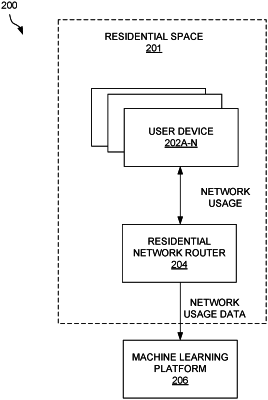| CPC G06Q 30/0204 (2013.01) [G06N 5/04 (2013.01); G06N 20/00 (2019.01); H04L 43/08 (2013.01); H04L 67/306 (2013.01)] | 14 Claims |

|
1. A non-transitory computer readable medium storing computer code executable by a processor to perform a method comprising:
collecting, by a system, network usage data from each residential network router of a plurality of residential network routers operating in a different residential space of a plurality of residential spaces, wherein each residential network router of the plurality of residential network routers is configured to aggregate raw usage data into the network usage data and to communicate the network usage data to the system;
processing, by a machine learning algorithm of the system, the network usage data to segment the plurality of residential spaces into a plurality of segments, wherein the machine learning algorithm:
discovers the plurality of segments as dense clusters of residential spaces with similar network usage behavior, and
characterizes each segment of the plurality of segments according to residential space features that are key differentiators for the segment,
predicts an affinity of each residential space of the plurality of residential spaces to each segment of the plurality of segments, and
assigns each residential space of the plurality of residential spaces to one segment of the plurality of segments based on the affinity of the residential space to each segment of the plurality of segments, including verifying stability of the affinity of the residential space to the one segment of the plurality of segments,
wherein the stability is verified by:
collecting a time series of affinity probabilities of each household over a period of time,
performing a change point analysis on the time series to detect significant changing points that differentiate between outliers and actual behavior drifts, and
selecting a changing point as a drift from segment behavior; and
for at least one segment of the plurality of segments:
determining, by the system, at least one of a digital content or a digital service correlated with the segment,
determining, by the system, the residential spaces assigned to the segment by the machine learning algorithm, and
providing, by the system, the at least one of the digital content or the digital service to residents of the residential spaces assigned to the segment.
|